Another look at winter rain’s impact on snow mold fungicides
It doesn’t take a climate scientist to tell us that our winters are changing. Warmer temperatures are leading to more winter rainfall and snowmelt events. That and decreased plant hardening in the fall can leave turf susceptible to snow mold development.
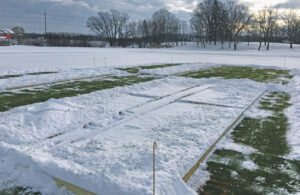
(Fig 1) The research plot at the OJ Noer Turfgrass Research Facility in November 2015. Half the plots were kept covered in snow for the entire winter and half the plots had snow removed for the entire winter. (Photo: Paul Koch)
In 2015, we published an article detailing the results of our research investigating how variable winter conditions impacted the persistence of iprodione and chlorothalonil and whether that impacted the development of snow mold in the growth chamber (Koch et al., 2015). We found that concentrations of both fungicides declined rapidly following a rainfall or snowmelt event, translating to increased Microdochium patch development levels in the growth chamber.
This study provided important information about what happens to their protection over time for golf course superintendents who apply snow mold fungicides. However, a couple of important questions related to snow mold fungicide persistence remained unanswered.
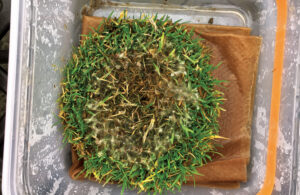
(Fig 2) One of the two cores collected from each plot was taken to the growth chamber and inoculated with the pink snow mold fungus to determine the level of disease protection that remained on the plant. (Photo: Paul Koch)
First, how did a xylem-mobile fungicide like propiconazole respond to variable winter conditions? Second, would an antitranspirant applied to the turf after fungicide application help protect the products from the degrading effects of rainfall and snow melt?
To answer these new questions, we conducted a second study at the O.J. Noer Turfgrass Research and Education Facility in Madison, Wis., using propiconazole, chlorothalonil and the antitranspirant TransFilm. The scientific article detailing this research was recently published in Plant Disease (Hockemeyer et al., 2024).
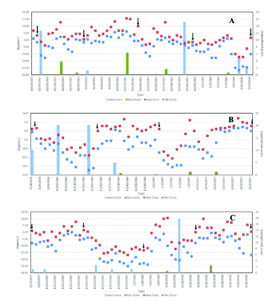
(Fig 3) Daily high and low temperatures and precipitation events for Madison, Wis., during the winters of 2015-2016 (A), 2016-2017 (B) and 2017-2018 (C). Black arrows indicate sampling dates.
The study
We conducted this experiment during the winters of 2015-2016 through 2017-2018 on fairway-height Penncross creeping bentgrass (Figure 1). The treatments included the contact fungicide chlorothalonil applied as Daconil WeatherStik, the xylem-mobile fungicide propiconazole applied as Banner MAXX and the antitranspirant TransFilm.
Our team applied each fungicide to plots where the snow was either removed after each snowfall or kept under at least 4 inches of snowfall for the entire winter, and each fungicide was applied either alone or in concert with an antitranspirant. We applied treatments shortly before the first significant snowfall in Madison each winter. Approximately one hour following the application of fungicides, we sampled two 2.5-inch cores from the center of each plot using a power drill with a hole-saw attachment.
We immediately transported the cores to the University of Wisconsin-Madison campus, where one core was designated for fungicide analysis using LC/MS, and the second core was placed in a growth chamber for inoculation with Microdochium nivale (Figure 2).
Our team collected repeat samplings at two-week intervals for the remainder of each winter until the snow completely melted, the bioassay indicated limited disease suppression remaining or LC/MS analysis revealed no fungicide remaining in the samples. On snow-covered plots, we cleared a small area of snow using a shovel before sampling and immediately replaced following sample collection.
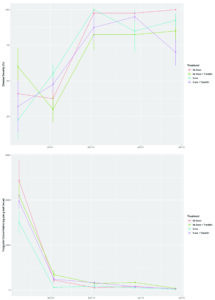
(Fig 4) Microdochium patch development (top) and chlorothalonil concentration (bottom) were assessed during each sampling date during the winter of 2015-2016 (Year 1) in Madison, Wis.
The results
Different weather conditions led to slightly different results each winter (Figure 3). In 2015-2016, there was an early snowfall event followed by warm temperatures and multiple rainfall events. In 2016-2017, the winter was cold and snowy until early January, when warm temperatures resulted in lots of melting snow. In 2017-2018, small snow events and warm temperatures resulted in regular melting and inconsistent snow cover in December before more regular snow and colder temperatures arrived in mid-January.
This study produced many interesting results, but we identified three as the most important. The first, and probably most important for golf course superintendents, was that rainfall and snowmelt events were the most significant environmental factors that led to fungicide degradation. This was evident in 2015-2016 when numerous rainfall events in November and December led to rapid drops in both chlorothalonil and propiconazole concentration and corresponding increases in disease development in the bioassay (Figures 4 and 5).
It was also evident to a lesser degree in 2017-2018 when late winter rains coincided with residues rapidly dissipating at 42 and 56 days after application. The opposite was also true in 2016-2017 when there was minimal rainfall and colder temperatures, and concentrations of chlorothalonil remained high until rainfall events in January led to rapid dissipation. These results are very similar to the ones we observed from our previous study published in 2015.
The second main result was that the type of fungicide also had little impact on persistence. Chlorothalonil is a contact fungicide that is very insoluble in water, while propiconazole is a penetrant xylem-mobile fungicide that is over 100 times more soluble than chlorothalonil. In 2015-2016 and 2017-2018, both fungicides degraded in a similar manner, suggesting that topical mode of action and water solubility have minimal effects on residue dissipation over winter.
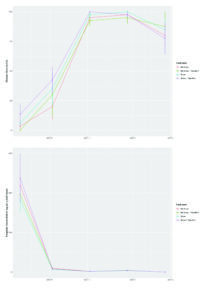
(Fig 5) Microdochium patch development (top) and propiconazole concentration (bottom) were assessed during each sampling date during the winter of 2015-2016 in Madison, Wis.
But in 2016-2017, chlorothalonil concentration remained steady 49 days after application while propiconazole was almost completely gone by day 28. This winter was characterized by early and heavy snowfall, only mild snowmelts and very little winter rain. With the lack of snowmelts and winter rains, it appears that chlorothalonil remained on the turf leaves for much longer than propiconazole, which was affected by even modest snowmelts and winter rains.
Previous research conducted in our lab observed that there is limited upward movement of propiconazole in the plant during the fall and winter months, suggesting that much of the fungicide residue remains on the outside of the plant and is susceptible to rainfall and snowmelt (González Vázquez et al., 2022).
The third main result was the role that TransFilm played in snow mold fungicide persistence. We observed that TransFilm modestly increased the length of disease suppression with chlorothalonil in 2015-2016. TransFilm is classified as a film-forming antitranspirant, which provides a barrier to plant water loss by coating plant leaves with wax, gel or plastics. We theorized that this moisture barrier may also work by limiting how much water from winter rains or snowmelt events could encounter fungicide residues and remove them from the leaf surface.
However, no impacts of TransFilm on chlorothalonil disease suppression were observed in the other two years. Further, the disease was higher when TransFilm was applied with propiconazole in years two and three of the study. While this study provided some evidence that TransFilm might help extend the persistence of contact fungicides like chlorothalonil, the mixed results provided here suggest that further research is required to more completely understand this relationship.
When should you reapply snow mold fungicides?
The question many of you probably have right now is how these results impact you, and more specifically, what do they say about the reapplication of snow mold fungicides following rainfall or snowmelt events?
This study agrees with our earlier research that clearly shows most of your snow mold fungicide dissipates quickly after it rains or warm temperatures cause the snow to melt, regardless of the fungicide or fungicide mixture you use (and mostly regardless of whether you use an antitranspirant or not).
What is more complex is whether a reapplication of snow mold fungicides is warranted. Most of the snow mold control provided by fungicides occurs because the fungicide is absorbed by the fungus shortly after application in the fall, not because the fungicide persists throughout the winter (Figure 6).
This means that in most cases, a reapplication is unnecessary to achieve effective snow mold control. Situations where a reapplication might be necessary include a rainfall event within a few days of the fungicide application or an early rainfall event in an area that traditionally has very long winters and experiences heavy snow mold pressure.
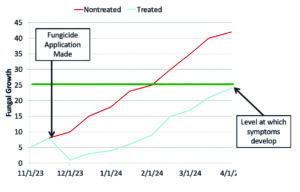
(Fig 6) Theoretical example illustrating the reduction in fungal growth that occurs after a snow mold fungicide application is made, which also demonstrates why reapplications of snow mold fungicides are typically not needed.
Conclusion
My initial thought was that warmer winters with increased rainfall would lead to less snow mold. However, what became apparent is that warmer temperatures in the fall result in more susceptible turf heading into the winter. In addition, rainfall and snowmelt result in more degradation of snow mold fungicide, decreasing the level of protection.
In short, warmer winters are making snow mold control more uncertain, and uncertainty during the winter can lead to lots of sleepless nights for superintendents. The research in this article provides important information about how snow mold fungicides react in a winter environment, and it will hopefully aid superintendents in developing strategies to improve snow mold control.
<p>The post Another look at winter rain’s impact on snow mold fungicides first appeared on Golfdom.</p>

